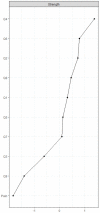Mapping Network Connectivity Among Symptoms of Depression and Pain in Wuhan Residents During the Late-Stage of the COVID-19 Pandemic
- PMID: 35370830
- PMCID: PMC8968182
- DOI: 10.3389/fpsyt.2022.814790
Mapping Network Connectivity Among Symptoms of Depression and Pain in Wuhan Residents During the Late-Stage of the COVID-19 Pandemic
Abstract
Background: Symptoms of depression and pain often overlap, and they negatively influence the prognosis and treatment outcome of both conditions. However, the comorbidity of depression and pain has not been examined using network analysis, especially in the context of a pandemic. Thus, we mapped out the network connectivity among the symptoms of depression and pain in Wuhan residents in China during the late stage of the COVID-19 pandemic.
Methods: This cross-sectional study was conducted from May 25, 2020 to June 18, 2020 in Wuhan, China. Participants' depressive and pain symptoms were assessed using the 9-item Patient Health Questionnaire (PHQ9) and a pain numeric rating scale (NRS), respectively. Network analyses were performed.
Results: In total, 2,598 participants completed all assessments. PHQ4 (fatigue) in the depression community showed the highest strength value, followed by PHQ6 (worthlessness) and PHQ2 (depressed or sad mood). PHQ4 (fatigue) was also the most key bridge symptom liking depression and pain, followed by PHQ3 (sleep difficulties). There were no significant differences in network global strength (females: 4.36 vs. males: 4.29; S = 0.075, P = 0.427), network structure-distribution of edge weights (M = 0.12, P = 0.541), and individual edge weights between male and female participants.
Conclusion: Depressive and pain symptoms showed strong cross-association with each other. "Fatigue" was the strongest central and bridge symptom in the network model, while "sleep difficulties" was the second strongest bridge symptom. Targeting treatment of both fatigue and sleep problems may help improve depressive and pain symptoms in those affected.
Keywords: COVID-19; Chinese; depression; network analysis; pain.
Copyright © 2022 Yang, Zhang, Yang, Li, Sha, Jia, Cheung, Zhang, Ng and Xiang.
Conflict of interest statement
The authors declare that the research was conducted in the absence of any commercial or financial relationships that could be construed as a potential conflict of interest.
Figures




Similar articles
-
Depression and quality of life among Macau residents in the 2022 COVID-19 pandemic wave from the perspective of network analysis.Front Psychol. 2023 Apr 24;14:1164232. doi: 10.3389/fpsyg.2023.1164232. eCollection 2023. Front Psychol. 2023. PMID: 37168423 Free PMC article.
-
Network analysis of comorbid insomnia and depressive symptoms among psychiatric practitioners during the COVID-19 pandemic.J Clin Sleep Med. 2023 Jul 1;19(7):1271-1279. doi: 10.5664/jcsm.10586. J Clin Sleep Med. 2023. PMID: 36988299 Free PMC article.
-
Network analysis of comorbid depression and anxiety and their associations with quality of life among clinicians in public hospitals during the late stage of the COVID-19 pandemic in China.J Affect Disord. 2022 Oct 1;314:193-200. doi: 10.1016/j.jad.2022.06.051. Epub 2022 Jun 30. J Affect Disord. 2022. PMID: 35780965 Free PMC article.
-
Network Analysis of Depressive Symptoms Among Residents of Wuhan in the Later Stage of the COVID-19 Pandemic.Front Psychiatry. 2021 Sep 30;12:735973. doi: 10.3389/fpsyt.2021.735973. eCollection 2021. Front Psychiatry. 2021. PMID: 34658968 Free PMC article.
-
Suicide ideation and anhedonia among clinically stable adolescents with the recurrent depressive disorder during the COVID-19 pandemic: A network perspective.J Affect Disord. 2023 Mar 1;324:317-324. doi: 10.1016/j.jad.2022.12.052. Epub 2022 Dec 19. J Affect Disord. 2023. PMID: 36549344
Cited by
-
Antidepressants and type 2 diabetes: highways to knowns and unknowns.Diabetol Metab Syndr. 2023 Aug 31;15(1):179. doi: 10.1186/s13098-023-01149-z. Diabetol Metab Syndr. 2023. PMID: 37653558 Free PMC article. Review.
-
Network analysis of meaning in life, perceived social support, and depressive symptoms among vocational undergraduate students.Front Psychiatry. 2025 Feb 4;16:1510255. doi: 10.3389/fpsyt.2025.1510255. eCollection 2025. Front Psychiatry. 2025. PMID: 39967583 Free PMC article.
-
The relationship between dimensions of empathy and symptoms of depression among university students during the COVID-19 pandemic: A network analysis.Front Public Health. 2022 Dec 22;10:1034119. doi: 10.3389/fpubh.2022.1034119. eCollection 2022. Front Public Health. 2022. PMID: 36620303 Free PMC article.
References
-
- Institute Institute for Health Metric and Evaluation: Findings From the Global Burden of Disease Study Seattle: IHME; (2017). Available online at: http://www.health.org/policy-report/findings-global-burden-disease-study... (accessed May28, 2021).
-
- World Health Organization: Depression Other Common Mental Disorders: Global Health Estimates. (2017). Available online at: https://apps.who.int/iris/handle/10665/254610 License: CC BY-NC-SA 30 IGO (accessed May 18,2021).
LinkOut - more resources
Full Text Sources

